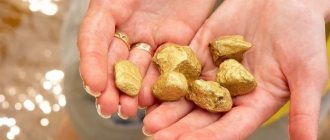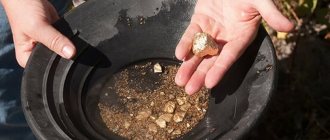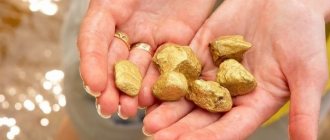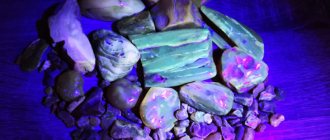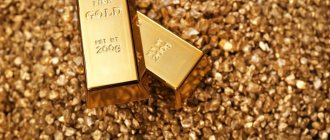There are places in Russia where everyone can engage in independent gold mining. But, of course, you must first obtain the appropriate permission. There are several rivers through which you can get quite rich if you work hard.
Bom
There are also quite a few small particles of pure gold here, but you can also find nuggets weighing up to 50 g. Gold grains are scattered throughout the reservoir.
You should look especially carefully in the cracks between shale rocks. It is there that up to one and a half kilograms of precious metal accumulates.
In which Russian rivers can you pan for gold?
Russia is a country extremely rich in placer gold. And to feel the spirit of a real gold rush, you don’t have to go to Kolyma. You can try yourself as a prospector closer to home - after all, even in the rivers of the Moscow region you can find gold if you try. But whether it will pay off your efforts is unknown.
It is much better to start searching for deposits that have already been developed industrially. Even after the mines are closed, a lot of gold remains in small areas that are of no interest to industrialists. There are plenty of places like this in Russia, so grab your prospector's tray and metal detector and go treasure hunting. Just get a private prospector's license first; in Russia they take this very seriously.
Sanarka River
In the 19th century, Sanarka was known throughout the world as the richest deposit of precious stones and minerals, with the light hand of Academician Koksharov called “Russian Brazil”. In some places, the river soil is gold-bearing. The now abandoned Andreevsky mine reminds us that there was once much more gold here.
Lena River Basin
The Lensky gold-bearing region is one of the richest in Russia. Over more than 150 years of mining, about 1.5 thousand tons of precious ore have been mined here. But there is still a lot of gold left in the depleted deposits, which is not subject to industrial extraction.
Bodaibo River
This gold-bearing river is located in the central part of the Patom Highlands. Alluvial gold from placers in the Bodaibo basin is predominantly large: gold particles from 2 to 4 mm predominate. Grains larger than 8 mm are often found. There are nuggets - the largest of them were found in the placer of the upper reaches of the Bodaibo River.
Big Chanchik River
About ten years ago, the bed of the Bolshoy Chanchik was mined using a scoop dredge. But according to geological data, large gold remains on Chanchik, and there are nuggets weighing several kilograms, which can be found with the help of a good old metal detector.
Bom River
The Bom is gold-bearing along its entire length. Gold in placers is large, nuggets weighing 10-30 grams are often found, less often up to 400 grams. In some places, gold lies right in the riverbed in crevices between shale rocks. Sometimes a very large amount of gold accumulates in such “nests” - up to one and a half kilograms.
Alekseevsky Stream
The gold here is large (nuggets weighing up to 1 kg), well rounded, and often fused with pieces of quartz. The largest nuggets are found at the top of the stream, under large boulders. A team of 2-3 people can easily pan for more than 300 grams of gold here.
Jalon Creek
The most profitable mine in the Dambukinsky gold-bearing region. The first samples showed up to 2.5 kg of gold per ton of sand. When the rich parts of the gold-bearing layer were mined here, its surface, after the rains washed away the sand, shone with nuggets that were easily visible to the naked eye.
Talga River
The gold content of the Talga River basin has been known since 1893. The exploitation of placers was carried out by miners mainly using the pit method. And over half a century (from 1893 to 1949), actual production amounted to at least 2800 kg. You can still stumble upon palm-sized nuggets here to this day.
Millionny Stream
The rich placer was found here by accident: in 1896, a pack horse belonging to a group of alcohol carriers (smugglers who delivered alcohol to the mines in exchange for gold) fell into a ravine. When they began to pull her out, nuggets were found at the bottom of the stream. The placer turned out to be very rich - in a month they managed to extract more than 640 kg of large gold. When the government found out about the illegal mine, the black miners were dispersed, but since then they have not been able to find the source of the nuggets.
Unaha River
The largest tributary of the river. Bryanta. Unakha is a typical mountain river with a winding bed and fast current. Where its rocky bottom comes to the surface, whole placers of precious metal are found in the crevices of the rock. Gold was mined by miners with trays and scooped out with ladles from ferries. Modern miners come here with metal detectors.
Big Chanchik
Just a few years ago, gold mining enterprises operated here. They extracted everything they could. But geologists still claim that it is quite possible to find large gold here. When using a gold digger, you can even find nuggets weighing several kilograms.
Alekseevsky stream
In this place it is possible to find large nuggets, which are located mainly in the upper reaches. If you gather a team of 2 - 3 people, you can extract about 500 g of pure gold during the day. If you are lucky, you will also find large nuggets that weigh approximately 1 kg.
Where to look for and pan for gold
Noble metal carried by water flow is called alluvial metal. Such gold breaks off from the bedrock under the influence of gravitational forces, weathering and chemical attack. Placers of precious metal are terraced, bottom and spit.
The first signs of the presence of a deposit are often found along river banks. A water stream with a strong current gradually cuts deeper and deeper into the surface of the earth, forming terraces at the upper level. Large deposits of terraced gold can be found not only near existing rivers, but also in places where streams have long since dried up.
Bottom deposits are formed as a result of the seepage of metal particles through dense layers of rock to the bedrock bed. Experts recommend looking for gold where the bedrock is shallow. On the river bank, mining from placers located on sand or pebble spits can bring success.
The noble metal does not always reach the bedrock. It can become stuck in dense clay if the current is not strong enough to wash it away. Gold is heavier than clay, but it cannot penetrate through several layers of well-compacted material. In this case, the precious metal must be looked for close to the surface of such false bedrock.
Particles of yellow metal move only where the flow speed is high. In mountain streams and rivulets you can try your luck near large boulders, where natural traps form. In these places, the current slows down sharply and the golden sand sinks to the bottom. Such “pockets” most often form in front of and directly behind large boulders. A more attractive trap is the one downstream, where the gold is purer.
The most interesting areas to search are places where the strength of the flow decreases. At bends in the riverbed, gold in rivers moves under the influence of centrifugal forces. On the outside of the stream the flow is faster than on the inside. Accordingly, the sandbars and spits at the beginning of the inside turn are good places to explore.
The flow moves most powerfully during the spring flood. At the same time, the channel expands and changes its boundaries. It is useful to measure its width and calculate the core of the river, taking into account its bends. Metal particles always follow the shortest path. When the river returns to its original state, searches should be conducted along the calculated trajectory.
The speed of the flow slows down sharply at the point where the tributary flows into a lake or other river. Accordingly, the zone of potential gold deposition will be the beginning of the mouth. You can start your search in the area where the river exits the mountains onto the plain. The optimal place is the area where a stormy stream flows into a river.
Of interest to gold miners are waterfalls, under which a whirlpool and a pit form. This is a kind of natural filter for gold sand and nuggets. First of all, you should pay attention to the area where the flow exits the pool. Sometimes gold can be found right where the water falls. It is also recommended to examine the boulders.
Gold is 19 times heavier than water. It does not float, but drags along the bottom of the river. Therefore, it is necessary to look for the noble metal where barriers are erected in the path of the flow. Cracks and caverns, boulders, fallen tree trunks, shallows, spits, ledges and irregularities, holes and whirlpools are the main places for prospectors to explore.
Yellow metal satellites
The list of minerals that coexist with gold is quite long. Silver is most often found together with the noble metal. Other satellites: platinum, quartz, adularia, galena, pyrite, lead. The combination of these elements with gold can be very different.
However, the presence of these minerals does not always indicate the presence of yellow metal. But if a nugget is found, it always contains silver. Its share can range from a few tenths of a percent to significant amounts. The optimal ratio of the two precious metals is found in volcanic rock.
Necessary tool
Prospectors use special equipment to identify gold. The most traditional device is a metal detector, which allows you to probe the soil to a depth of 15 cm to 1 m. The main problem is its excessive sensitivity. The device is not tuned to yellow metal, i.e. the signal from iron and gold will be the same.
Today, more advanced special instruments have been developed that make it possible to search for nuggets at a depth of up to 1 m. This gold probe is equipped with a probe with a sensor device. A signal about the presence of a precious metal is given by direct contact with it. Unlike a metal detector, this equipment is not sensitive to soil type.
Searching with a metal detector
To search for gold in the ground and river beds, you must correctly set the sensitivity of the metal detector. The number of false signals that the device gives depends on it. It is also necessary to configure the ground balance function. This parameter will have to be adjusted every few minutes, since the composition of the soil is constantly changing.
When working with a metal detector, the coil should be kept as close to the ground as possible. When a signal is received, it is recommended to “listen” to the soil in all directions. If the sound fades quickly, then the signal is false. A similar check is carried out by lifting the coil up.
Million Stream
Finders acting illegally were able to extract over 640 kg of pure gold here. They were the ones who found a hidden area at the bottom of the stream where there are nuggets. Quite large pieces of valuable metal can still be found here. Moreover, the enterprises have not yet produced production on an industrial scale.
Mining gold is a pleasant business, but quite difficult. But such work is compensated by decent earnings! So it's still worth a try.
Subscribe to our Yandex Zen channel and give it a thumbs up!

